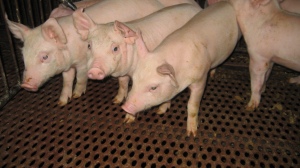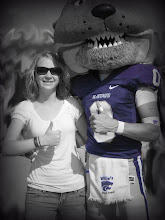The Kansas swine industry is a vigorous business with producers marketing approximately 2.5 million pigs at a gross market value of over $3 million. Being the 9th top pork producing state and turning out 2.8% of the nation’s total production is no easy task; in fact it’s a team effort.
Leading the way through research, the K-State Swine Team works with producers and industry leaders to develop, evaluate, implement and disseminate the latest technology to increase the profitability of Kansas pork producers. Based out of K-State’s Department of Animal Sciences and Industry and armed with the support of the Kansas Pork Association, the KSU Livestock and Meal Industry Council, direct swine producers and allied industry donations; the Swine Team aims simply to educate producers.
“It’s a fairly applied program,” says Extension specialist, Bob Goodband. “We do a lot of research that we feel producers will find helpful and benefit from. We have the opportunity and ability to progress the industry, and that is something that we try very hard to do.”
To provide the best research requires the best facilities. The researching center is in the process of making an addition with a wean-to-finish facility. Extension specialist, Joel DeRouchey says the building will have the capability of weaning directly into this facility for research purposes. “This new building replaces an existing facility that was built in 1968, and also expands the number of pigs that can be housed indoors,” DeRouchey says. “Currently, dirt lots house pigs not used for research due to space limitations of the previous barn and those pigs for teaching purposes. This increase in barn size will allow for the removal of all outdoor lots, improving the environmental aspects of the farm by eliminating the need to contain rain runoff of the outdoor pens and reduce odor coming off of the dirt lots.” DeRouchey adds that the outdoor lots will be converted into crop ground with adjoining land currently in production.
DeRouchey says two of the four rooms will be identical in size and design, with 40
 pens each capable of housing up to eight pigs per pen (320 total per room). “These research rooms will be fed with a state of the art computerized feeding system, FeedLogic, which delivers feed on a rail system and has capabilities of blending diets together as feeders are filled. This offers more flexibility in research design for nutritional trials.”
pens each capable of housing up to eight pigs per pen (320 total per room). “These research rooms will be fed with a state of the art computerized feeding system, FeedLogic, which delivers feed on a rail system and has capabilities of blending diets together as feeders are filled. This offers more flexibility in research design for nutritional trials.”The other two rooms which are also identical in design, will have 22 pens capable of housing eight pigs per pen. “One of these rooms will house pigs for exploratory and pilot study research,” DeRouchey says. “The other room will house pigs that will be used for education and evaluation in the numerous undergraduate classes that utilize swine here on campus in our Weber Hall Arena. This room will also serve as the primary marketing room for additional pigs of various weights from the remainder of the university swine farm.”
DeRouchey also notes that the building itself will have the latest technologies of equipment, ventilation and feeding systems. The facility will also be utilized for educational training to graduate and undergraduate students to help prepare them for similar management techniques used in commercial operations.
Located at the edge of the K-State campus, the present Swine Teaching and Research Center has about 160 sows in production, which are of commercial line genetics. All females are bred by artificial insemination to terminal line boars. Sows are farrowed every 35 days and offspring are weaned into one of two nursery facilities. After seven weeks in the nursery facilities, pigs are moved to a growing facility or to one of three finishing buildings and utilized in research.
Goodband says current swine research is being done is promising for producers. “Right now our research includes looking at different types of feeders and feeder adjustments to see how it impacts performance,” he says. “We’re also doing some research on creep feeding to provid extra feed for piglets. A large focus is looking at DDGS feeding, with corn prices as high as they are, distillers are an economical alternative. Along with that we’ve been doing research on adding enzymes to feed to aid with digestability. When feeding distillers, there is a lot more fiber content so potentially by adding enzymes the fiber can be broke down a little better.” Goodband also mentions that researchers are always evaluating new protein sources for piglets and overall nutritional recommendations.
While construction crews are still bustling around the site of the soon to be building, the excitement is growing among Swine Team researchers who are eager put it to work. “One of our main focuses in the barns will be nutrition research to help producers best use ethanol co-products and other alternative ingredients in their swine diets without compromising pig performance or meat quality,” says Extension specialist Mike Tokach. “We are excited that the building will help us conduct research vital to helping Kansas producers deal with difficult production decisions.”
The hard work and research of the Swine Team doesn’t go unnoticed by the pork producers of Kansas. “The main jist of K-State research is to help producers lower the cost of production. About 60% of production cost is feed inputs, as grain prices have risen that percentage has went up considerably. What K-State does for producers is a very valuable resource,” says Kansas Pork Association President, Tim Stroda. “Much of the research that goes on through the K-State Swine Team heads towards the area of nutrition. Their research is very important to producers especially in times of high grain prices like now. Producers appreciate their ability and effort to help them make money. Our hope is that by supporting the facility enhancement project that producers will have that expertise at their fingertips for the next decades to come.”




No comments:
Post a Comment